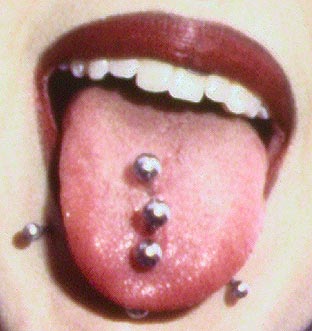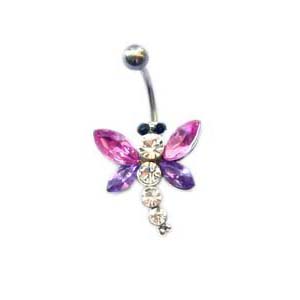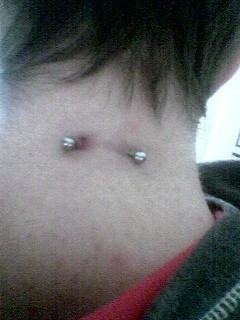 Of all the body piercings available, tongue piercings without a doubt spark the most controversy. A search in Google will bring up a half a million hits, and if you were to go through them, you would think getting a tongue piercing is a risk just short of playing russian roulette. Some of the worst horror stories include brain abscesses, spread of deadly diseases such as HIV, large build-ups of scar tissue, "suicide disease," permanent nerve damage and fatal toxic shock syndrome. If that's not enough to scare you away, you'll notice that you could bleed excessively, develop speech problems, experience serious swelling, and or chip teeth. Sounds dangerous, right? Absolutely!
Of all the body piercings available, tongue piercings without a doubt spark the most controversy. A search in Google will bring up a half a million hits, and if you were to go through them, you would think getting a tongue piercing is a risk just short of playing russian roulette. Some of the worst horror stories include brain abscesses, spread of deadly diseases such as HIV, large build-ups of scar tissue, "suicide disease," permanent nerve damage and fatal toxic shock syndrome. If that's not enough to scare you away, you'll notice that you could bleed excessively, develop speech problems, experience serious swelling, and or chip teeth. Sounds dangerous, right? Absolutely!As with any popular matter that involves some risk (recreational drugs, extreme sports, etc.) the media loves to play them up. Any serious incident creates attractive headlines and prominent news stories, in turn creating a sort of media gossip. This gossip circulates through the popular mediums, and the result is that the public hears about "headline news", and never the full story.
 In the case of tongue piercing, as an example, people may see that someone lost feeling in their tongue because of a botched piercing. A while later, they read that someone had a brain abscess, most likely caused from a tongue piercing. One thing leads to another, and the public comes to the conclusion that these piercings are very dangerous to get, and certainly outweigh any reason to get one. For most people it ends there.
In the case of tongue piercing, as an example, people may see that someone lost feeling in their tongue because of a botched piercing. A while later, they read that someone had a brain abscess, most likely caused from a tongue piercing. One thing leads to another, and the public comes to the conclusion that these piercings are very dangerous to get, and certainly outweigh any reason to get one. For most people it ends there.
What the majority don't realize, is that like anything that involves risk, there are ways to greatly minimize this risk. Tongue piercings are no different, and fortunately, it is possible to nearly eliminate the risks. The majority of the horror stories are either one-offs, or situations in which the people getting their tongue pierced did not make smart decisions. In fact, the only risk that is difficult to avoid and somewhat common is damage to teeth and gums. Dentists dislike tongue piercings because they receive patients coming in with cracked or chipped teeth, and/or receding gums. Again, smart and proper care greatly diminishes this risk, and with regular check-ups and advice from the dentist, this occurrence can also be minimized.
 By no means are tongue piercings one hundred percent safe. There is always a slight risk involved if you get your tongue pierced, but nothing compared to what the media would have you believe. A tongue piercing is a fun, unique piercing and by doing your research and making smart choices, you greatly reduce the chance of a bad outcome.
By no means are tongue piercings one hundred percent safe. There is always a slight risk involved if you get your tongue pierced, but nothing compared to what the media would have you believe. A tongue piercing is a fun, unique piercing and by doing your research and making smart choices, you greatly reduce the chance of a bad outcome.
So the next time you hear a horror story about tongue piercing, or any other thing that interests you, do some research. Find out for yourself if it's really such a major concern.

















